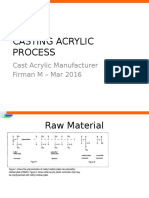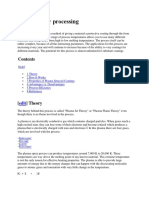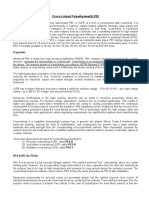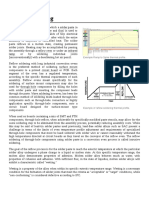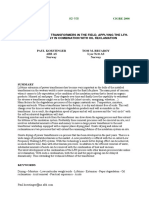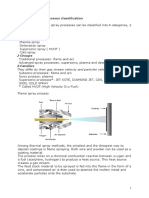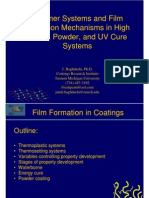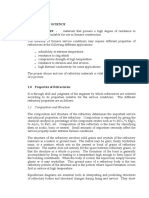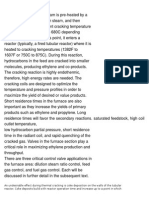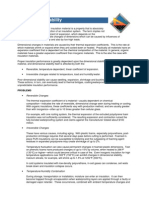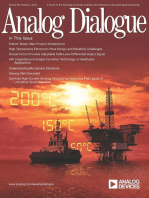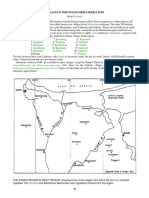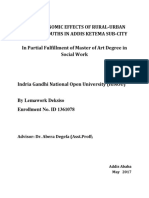Cure Matters - Epo-Tek
Cure Matters - Epo-Tek
Uploaded by
Celia ThomasCopyright:
Available Formats
Cure Matters - Epo-Tek
Cure Matters - Epo-Tek
Uploaded by
Celia ThomasCopyright
Available Formats
Share this document
Did you find this document useful?
Is this content inappropriate?
Copyright:
Available Formats
Cure Matters - Epo-Tek
Cure Matters - Epo-Tek
Uploaded by
Celia ThomasCopyright:
Available Formats
Cure Matters
Determining the Proper Cure Schedule
After selecting the appropriate adhesive, determining the proper cure schedule is a very important aspect to achieving
optimal adhesive performance for your specific application.
EPO-TEKs datasheets provide a great starting point for recommendations of cure temperatures and times. However,
each application is unique and may require its own unique curing profile in order to provide optimal performance.
Cure Temperature Considerations
The first place to start is: Cure Temperature. While some epoxies will cure at
room temperature, many will require an elevated temperature to initiate the
chemical curing reaction. Suggested minimum temperatures and times are
listed under the minimum cure section of the datasheet.
See EPO-TEK Tech Tip # 6 for more information on minimum bond line
cure information and remember that each application/project has many
variables such as: geometry, unique or substrates, thermal mass concerns,
etc. that should be taken into consideration. Minimum cure temperatures
stated on the datasheet should be taken as an initial recommendation only.
A minimum cure will result in a material that is dry to the touch and, in the case of electrically
conductive products, will also have some degree of electrical conductivity. There is often a
desire to cure at the lowest possible temperature or for the shortest period of time. While the
performance of minimally cured materials may be acceptable for certain applications, it is
important to note that the adhesive most likely will not exhibit its full mechanical, electrical
or thermal properties.
Effect of Temperature on Cross Linked Density of an Epoxy
To reach the full performance potential of an epoxy adhesive, the user should select a cure schedule that achieves a
high cross-link density. Typically, higher temperatures produce a more complete reaction with a greater degree of
cross-linking than lower temperatures. Alternatively, increasing the length of time for a lower temperature cure does
not always yield the same degree of crosslinking as curing at a higher temperature.
When an adhesive is cured at a lower temperature, the cross-links form slowly resulting in a more expanded network
structure. As the structure forms, the mobility of any unreacted groups in the structure gradually decreases and they
are impeded from migrating to the remaining open reactive sites. Once enough of this network structure has been
locked in, increasing the curing time at a given temperature will not further the degree of cross-linking. On the other
hand, extending the cure times for most epoxies will not harm them in any way as cure temperatures are well below
the thermal degradation temperatures of the epoxy.
For optimal cross-link density, curing at a high enough temperature will provide sufficient kinetic
energy to quickly initiate chemical reactions at even the most hindered locations and give the
molecules enough mobility to fully network. High cross-link density formation will enable your
cured material to exhibit the best possible mechanical and physical properties for that formulation.
Properties such as Tg, hardness, modulus, electrical conductivity, thermal conductivity, strength
and degradation temperature will be maximized and properties such as CTE, outgassing, and
moisture uptake will be minimized.
Crosslinked Epoxy
www.EPOTEK.com
Cure Speed Considerations
General Considerations
The process of transitioning from an uncured liquid state to a cured cross-linked
benefit. For instance, Thermal Conductivity and Electrical Conductivity are often
Uncured Adhesive
Drawing illustrates
the effects of proper
cure (shrinkage) for a
conductive filler system
Insulating Resin
Conductive
Filler
Heat Flow
High Resistance
Snap/Fast/High Temperature Cure
Faster, high temperature cures enable chemical cross-links to form faster and more completely. This generally
results in higher shrinkage than lower temperatures. In many cases, this shrinkage can provide benefit. For instance,
thermal conductivity and electrical conductivity can be enhanced as explained above.
Snap cures can also provide an added benefit by reducing resin bleed in some
situations. Resin bleed is usually a substrate dependent phenomenon and is
generally solved through modification of the substrate surface (see EPO-TEK
Tech Tip# 16), but it may also be impacted, to some degree, by the cure. The
surface tension or surface morphology of the substrate may actually attract
the resin component of the adhesive to migrate along the substrate surface.
However, this capillary-type migration occurs more readily with lower
viscosity resins or if the resin is in contact with the substrate for long periods
of time before curing. If an adhesive is heated slowly, it will drop in viscosity
Example of Resin Bleed
with increasing temperature until it reaches a high enough temperature for
cross-linking to begin and for the adhesive to start building its structure. Higher
temperature cures can initiate this cross-linking on a short enough time scale to prevent this initial viscosity drop
and deny the resin the time needed to migrate.
Low Temperature Cure
Many applications are very sensitive to the stress
that higher cure temperatures and resulting
higher degrees of shrinkage can produce. In
those cases, a lower temperature cure should
be used. While a low stress state is mostly
determined by the chemistry of the adhesive
selected, it can also be influenced by the cure.
The drawback of lower temperature cures is
that they may not yield the desired optimal
performance of a highly cross-linked system.
Different exotherm peaks for a typical epoxy at
80C, 90C, 100C and 110C.
- Snap/Low/Ramped/Staged
solid state will impart some degree of shrinkage to the cured adhesive. In many cases, this shrinkage can provide a
n enhanced by increasing the degree of shrinkage during cure as this brings the conductive filler particles closer together.
Cured Adhesive
Impact of cure conditions:
Cured Adhesive
Optimal shrinkage
Low shrinkage
Insulating Resin
Conductive
Filler
Insulating Resin
Too low of a cure temperature
will result in slow cure and low
crosslink density.
Too high of a cure temperature
can cause high exotherms that
may actually cause the system
to expand rather than shrink.
Proper cure conditions are
dependent on the chemistry of
the adhesives.
Conductive
Filler
Heat Flow
Heat Flow
Medium Resistance
Low Resistance
Ramped/Stepped Cure
In some cases, a significant increase in thermal conductivity can be achieved
through a proper stepped cure.
25.0
150C/1hr
ThK (W/mK)
Thermal Conductivity
One good compromise between a high and a low temperature cure is the ramped
or stepped cure. In this case, the cure temperature is slowly ramped up to the final
desired curing temperature. This often provides a good balance between lower
stress as the cross-linked structure is locked in more slowly and a higher overall
level of cross-linking as higher temperatures are ultimately achieved. For example,
a step cure for EPO-TEK 301-2 would be: 40C/1 hour followed by 80C/3
hours. This yields similar performance to EPO-TEK 301-2 cured directly at 80C,
but with lower stress.
Staged Cure
An extreme version of a ramped or stepped cure is a staged cure. The adhesive is left for
several hours at room temperature to begin to gel and build-up some structure before it
is placed into the oven for a higher temperature post cure. This generally works only for
adhesives capable of a low temperature cure. This can yield a very low stress final cured
state. However, the process needs to be managed carefully as small changes in ambient
temperature and humidity during the staging time may have a significant impact on the
resulting cured material (see EPO-TEK Tech Tip# 15). As so much of the network forms
during the long Room Temperature staging, the final curing density will not be as high
as for a direct cured material or even a ramped
product. The resulting material may have lower
Tg, hardness, modulus, conductivity, and cohesive
strength than a higher temperature direct cure
product, but it would have enhanced mechanical
properties over a product cured only at a lower
temperature.
20.0
22.0
200C/1hr
150C/1hr + 200C/1hr
15.0
10.0
12.6
8.8
5.0
0.0
EPO-TEK EK1000
Mass Consideration on Curing
Epoxies cure through an auto-catalytic process. This means that heat is generated during bond formation
and the initial cross-linking process. This generated heat speeds up the curing reaction, which then generates
additional heat, speeds up the reaction further and so on. The larger the volume of reacting material, the
faster it will cure and the more heat is built up during the cure.
Large masses of materials may build up so much heat during curing that a runaway reaction occurs and
they actually expand during the cure. This is referred to as an excessive exotherm. In extreme cases, highly
exothermed materials may appear to have foamed due to the large amounts of air present in the expanded
state. Severely exothermed materials may exhibit weakened mechanical properties as they have essentially
become a foamed system. Loss in cohesive strength, decreased modulus and hardness, and increased CTE
can occur. Both electrical and thermal conductivities may also suffer.
Epoxy Exotherm
Ramped or stepped cures are a good way to avoid runaway reactions for curing large volumes of materials. This
slows down the reaction rate, but still enables the material to see the high ultimate curing temperatures needed for full cross-linking.
Very small volumes of material should be cured at higher than usual temperatures and most likely for longer times in order to ensure proper
curing. As there is no risk of a runaway reaction with the small volume (unless temperatures used are excessive) it is unlikely that high stress is
involved at the small size scales. These applications should generally employ a direct, high temperature cure.
An example of this would be a 9mil x 9mil die for die attach in high brightness LEDs. Here the adhesive has a much higher ratio of surface
area to volume. The result is that any extra heat generated by the epoxy curing process is quickly wicked away through the high surface area.
Adhesive Areas
Another factor to consider is whether there are any large fixtures or thermal
masses that are part of the curing process such as a heat sink. Any such masses
will absorb heat during the cure and it may take longer for the heat to reach the
adhesive being cured. As a result, the temperature profile seen by the adhesive
during a direct cure may effectively look more like a ramped cure as it takes more
time for the entire mass to heat up to the oven temperature. Cure temperatures
and/ or times should be increased for processes involving large thermal masses.
Light Emitting Diode (LED)
Special Standards / Testing Notes:
For products tested to meet specific standards for example; USP Class VI or
NASA low outgassing, it is important to note how the product was cured for
these tests as alternate cure schedules may not deliver the same performance.
Please consult our Technical Services Experts at Epoxy Technology for any questions
or assistance you may need in working with our EPO-TEK adhesives.
Contact Information: techserv@epotek.com or 978-667-3805.
Epoxy Technology Inc. 14 Fortune Drive Billerica, MA 01821
phone 978-667-3805 fax 978-663-9782 techserv@epotek.com
www.EPOTEK.com
EPO-113-01
You might also like
- Casting Acrylic ProcessDocument32 pagesCasting Acrylic ProcessFirman Muttaqin100% (3)
- Advanced Temperature Measurement and Control, Second EditionFrom EverandAdvanced Temperature Measurement and Control, Second EditionNo ratings yet
- Field Guide 2 Optomechanical Design Analysis 12Document163 pagesField Guide 2 Optomechanical Design Analysis 12Horaxio Gtz100% (1)
- 07 - Chapter 2 PDFDocument28 pages07 - Chapter 2 PDFCeren AkyosNo ratings yet
- Lesson 30. Thermoplastic and Thermosetting PolymersDocument11 pagesLesson 30. Thermoplastic and Thermosetting PolymersNizar AbrorNo ratings yet
- What Is Cross Linked PolyethyleneDocument14 pagesWhat Is Cross Linked PolyethyleneYongki Yo'el Gibranto100% (1)
- Cjob TutorialDocument28 pagesCjob TutorialCelia ThomasNo ratings yet
- Peugeot Planet Guide (ENG)Document41 pagesPeugeot Planet Guide (ENG)Celia Thomas100% (1)
- BEKO Dishwasher - Programs TableDocument1 pageBEKO Dishwasher - Programs TableCelia ThomasNo ratings yet
- Genealogies - New Castle Historical SocietyDocument2 pagesGenealogies - New Castle Historical Societyapi-234391427No ratings yet
- (Robert E. Sheriff (Auth.) ) Seismic StratigraphyDocument234 pages(Robert E. Sheriff (Auth.) ) Seismic StratigraphyMuhammad FaddhilaNo ratings yet
- Dust Bowl ExodusDocument6 pagesDust Bowl ExodusDalane BollingerNo ratings yet
- The Major Characteristics of AdhesivesDocument9 pagesThe Major Characteristics of Adhesivesrodrigo_venancioNo ratings yet
- 2003 Potting Hillman-BaylakogluDocument9 pages2003 Potting Hillman-BaylakogluVansala GanesanNo ratings yet
- Thermal Management of Electronics DevicesDocument4 pagesThermal Management of Electronics Devicesrpselvakumar2008No ratings yet
- VaporPhaseWhitePaper - Approved TextDocument3 pagesVaporPhaseWhitePaper - Approved TextKevin Angelo MaNo ratings yet
- Chapter 4. FRC Manufacturing - Fundamental ConceptsDocument5 pagesChapter 4. FRC Manufacturing - Fundamental ConceptsNarendra GadkariNo ratings yet
- Plasma Spray ProcessingDocument15 pagesPlasma Spray ProcessingRakesh SahuNo ratings yet
- 1525855083module-8 Unit-3 NSNTDocument6 pages1525855083module-8 Unit-3 NSNTNivetha GeorgeNo ratings yet
- Thermal Management of Electronic DevicesDocument3 pagesThermal Management of Electronic DevicesHamed KianyNo ratings yet
- Paper CompositesWorld Evonik Oct2017Document12 pagesPaper CompositesWorld Evonik Oct2017uzzy2No ratings yet
- Zhao 2020Document7 pagesZhao 2020Jeffrey JohnsonNo ratings yet
- Cross-Linked Polyethylene (XLPE) : PropertiesDocument2 pagesCross-Linked Polyethylene (XLPE) : PropertiesSdkmega HhNo ratings yet
- The Preparation and Evaluation of Thermal Spray Coatings - Mounting PDFDocument6 pagesThe Preparation and Evaluation of Thermal Spray Coatings - Mounting PDFycwbycwbNo ratings yet
- Power Law CoefficientDocument2 pagesPower Law CoefficientMervyn JohnNo ratings yet
- Reflow Soldering: Reflow Soldering Is A Process in Which A Solder Paste (ADocument5 pagesReflow Soldering: Reflow Soldering Is A Process in Which A Solder Paste (AMadhusudanan AshokNo ratings yet
- Electronic Materials and Components-Die Bonding MaterialsDocument23 pagesElectronic Materials and Components-Die Bonding MaterialsYue KaiNo ratings yet
- Module 2Document23 pagesModule 2Dhanya MenonNo ratings yet
- PAPER CIGRE Drying of Power Transformers in The Field Applying The LFH Technology in Combination With Oil Reclamation 2006Document8 pagesPAPER CIGRE Drying of Power Transformers in The Field Applying The LFH Technology in Combination With Oil Reclamation 2006Alonso Lioneth100% (1)
- An In-Depth Look at Polymer QuenchantsDocument4 pagesAn In-Depth Look at Polymer QuenchantsJader PitangueiraNo ratings yet
- Thermal Spray Processes ClassificationDocument7 pagesThermal Spray Processes ClassificationinterponNo ratings yet
- Polymer Systems and Film Formation Mechanisms in HighDocument57 pagesPolymer Systems and Film Formation Mechanisms in HighUsama AwadNo ratings yet
- Exploring High Temperature Reliability Limits For Silicone AdhesivesDocument8 pagesExploring High Temperature Reliability Limits For Silicone Adhesivesrodrigo_venancioNo ratings yet
- Spe 139308 MSDocument10 pagesSpe 139308 MSLeopold Roj DomNo ratings yet
- High Solids StrategyDocument12 pagesHigh Solids StrategyGladys Anne ZubiriNo ratings yet
- Ablative CoolingDocument5 pagesAblative CoolingTarek ElmasryNo ratings yet
- Simplification of Isolation Product Selection Through Advanced Design GPT IndustriesDocument6 pagesSimplification of Isolation Product Selection Through Advanced Design GPT Industriespayam.ghafooriNo ratings yet
- RF Sealing TheoryDocument3 pagesRF Sealing Theorykirandasi123No ratings yet
- Unit 5.6. Thin Films and Nanomaterials - SKM, SADocument11 pagesUnit 5.6. Thin Films and Nanomaterials - SKM, SAJames WankerNo ratings yet
- Differential Scanning Calorimetry (DSC) and Torque Rheometry: A Viable Combination For Determining Processing Parameters of Thermosetting PlasticsDocument7 pagesDifferential Scanning Calorimetry (DSC) and Torque Rheometry: A Viable Combination For Determining Processing Parameters of Thermosetting Plasticsgunawan refiadiNo ratings yet
- Ultrasonic Technology Seals The DealDocument10 pagesUltrasonic Technology Seals The DealНиколайNo ratings yet
- Investigation of The Quenching Properties of Selected Media On 6061 Aluminum AlloyDocument13 pagesInvestigation of The Quenching Properties of Selected Media On 6061 Aluminum AlloyEyecatching ShopNo ratings yet
- SPE 135101 Successful High-Temperature, Water-Control Case Histories in Highly Naturally Fractured Carbonate ReservoirsDocument15 pagesSPE 135101 Successful High-Temperature, Water-Control Case Histories in Highly Naturally Fractured Carbonate ReservoirsLeopold Roj DomNo ratings yet
- Electrolube Thermal Management Solutions 2018 RUDocument16 pagesElectrolube Thermal Management Solutions 2018 RUlqn28351No ratings yet
- Lecture 9 Solid InsulatorsDocument8 pagesLecture 9 Solid InsulatorsMehmet Efe OzbekNo ratings yet
- Advances in Thermal Spray TechnologyDocument3 pagesAdvances in Thermal Spray Technologyinterpon07No ratings yet
- Power Transformers: Overview Factors On Assessing Insulation LifeDocument8 pagesPower Transformers: Overview Factors On Assessing Insulation LifeДенис ЛяпуновNo ratings yet
- MEMS Thin Film Deposition ProcessesDocument4 pagesMEMS Thin Film Deposition ProcessesIndraysh Vijay [EC - 76]No ratings yet
- Study QuestionsDocument10 pagesStudy QuestionsBithiah BidsNo ratings yet
- Refractory Science Refractories - : 1.1 Composition and StructureDocument14 pagesRefractory Science Refractories - : 1.1 Composition and StructureNikki AlbiosNo ratings yet
- An Undesirable Effect During Thermal Cracking Is Coke Deposition On The Walls of The Tubular Reactor. Coke Deposits Build With Reactor Operation Time and Increase Up To A Point in WhichDocument2 pagesAn Undesirable Effect During Thermal Cracking Is Coke Deposition On The Walls of The Tubular Reactor. Coke Deposits Build With Reactor Operation Time and Increase Up To A Point in WhichWindhi Hoshi Yumemizu IINo ratings yet
- Will - 2013Document9 pagesWill - 2013thuronNo ratings yet
- Epoxy CureDocument5 pagesEpoxy CureElias Kapa100% (1)
- Joining of PlasticsDocument39 pagesJoining of PlasticsLakshmanan VenkatesanNo ratings yet
- Reworking Cured EpoxyDocument1 pageReworking Cured EpoxyWaqas KhanNo ratings yet
- PEXa, PEXb, PERT - Advantages - ProcessDocument2 pagesPEXa, PEXb, PERT - Advantages - ProcessMidhun Mohan MNo ratings yet
- MEMS Thin Film Deposition ProcessesDocument8 pagesMEMS Thin Film Deposition ProcessesJems BondNo ratings yet
- Bonding of Plastic Parts Opportunities For Future Automotive Contuction Dr. Hartwig Lohse, Ashland Specialty Chemical Company, Germany 00BSM011Document8 pagesBonding of Plastic Parts Opportunities For Future Automotive Contuction Dr. Hartwig Lohse, Ashland Specialty Chemical Company, Germany 00BSM011olah_laci3245No ratings yet
- Elcat Thermal GBDocument20 pagesElcat Thermal GBAlexandreNo ratings yet
- Dimensional Stability: ProblemsDocument4 pagesDimensional Stability: ProblemsHilman SyehbastianNo ratings yet
- Thrust Chamber CoolingDocument15 pagesThrust Chamber CoolingSundar MahalingamNo ratings yet
- Moisture in Transformers - en - v03Document9 pagesMoisture in Transformers - en - v03gtamez0918No ratings yet
- Low Coefficient of Thermal ExpansionDocument13 pagesLow Coefficient of Thermal ExpansionnileshsawNo ratings yet
- Heated Regulators For Vapor and Liquid HydrocarbonsDocument4 pagesHeated Regulators For Vapor and Liquid HydrocarbonsSamit ShaikhNo ratings yet
- Interpreting Unexpected Events and Transitions in DSC ResultsDocument5 pagesInterpreting Unexpected Events and Transitions in DSC Resultszhor El hallaouiNo ratings yet
- Thermal Modelling of Power Transformers Using Computational Fluid DynamicsFrom EverandThermal Modelling of Power Transformers Using Computational Fluid DynamicsNo ratings yet
- Phase Extenders and MFMDocument1 pagePhase Extenders and MFMCelia ThomasNo ratings yet
- H. Spikes, The History and Mechanisms of ZDDP, Tribology Lett, 17 (3), Oct 2004Document21 pagesH. Spikes, The History and Mechanisms of ZDDP, Tribology Lett, 17 (3), Oct 2004Celia ThomasNo ratings yet
- BSI - The Keystone' of PSA MultiplexingDocument3 pagesBSI - The Keystone' of PSA MultiplexingCelia Thomas100% (2)
- European Immigration. A Sourcebook (Ashgate, 2007) PDFDocument397 pagesEuropean Immigration. A Sourcebook (Ashgate, 2007) PDFMagda V.No ratings yet
- Anti Static Master BatchesDocument7 pagesAnti Static Master Batchesranganathan_sathishkumarNo ratings yet
- Important Order and Facts of Organic ChemistryDocument6 pagesImportant Order and Facts of Organic ChemistryDEEPAK KUMAR MALLICKNo ratings yet
- USSD - 2014 Sangho LeeDocument13 pagesUSSD - 2014 Sangho LeeSebas GutierrezNo ratings yet
- Dispersal and Migration IvovicDocument38 pagesDispersal and Migration IvovicFahrudin HajdarevićNo ratings yet
- Activities Unit 1 (3º ESO) (2023 - 2024) - 231022 - 184116Document8 pagesActivities Unit 1 (3º ESO) (2023 - 2024) - 231022 - 184116mactraher63No ratings yet
- Lament PresentationDocument21 pagesLament PresentationSimran Nova SiddiqueNo ratings yet
- Usman VisaDocument3 pagesUsman Visavisaguru75No ratings yet
- Climate Change, Water Stress, Conflict and Migration - Climate Change, Conflict and Migration (PDFDrive)Document130 pagesClimate Change, Water Stress, Conflict and Migration - Climate Change, Conflict and Migration (PDFDrive)asishNo ratings yet
- A Path To Efficient Data Migration in Core BankingDocument8 pagesA Path To Efficient Data Migration in Core BankingCognizantNo ratings yet
- Checklist of Birds El Cielo, ArvinDocument25 pagesChecklist of Birds El Cielo, ArvinJorge Valencia HerverthNo ratings yet
- Corruption Development and Institutional Design International Economic Association Conference Volume No 145 PDFDocument290 pagesCorruption Development and Institutional Design International Economic Association Conference Volume No 145 PDFOnoirinaNo ratings yet
- International Migrations To Brazil in The 21st CenturyDocument35 pagesInternational Migrations To Brazil in The 21st CenturyMarie DupontNo ratings yet
- Legacies of Historical Globalization: DepopulationDocument5 pagesLegacies of Historical Globalization: Depopulationapi-490788696No ratings yet
- IWCF Workbook Instructor Solution KeyDocument32 pagesIWCF Workbook Instructor Solution KeyElrohirPendragon83% (6)
- Visa TouristDocument1 pageVisa TouristAsad KhawajaNo ratings yet
- Lecture 9. Population and UrbanizationDocument24 pagesLecture 9. Population and Urbanizationhelper komNo ratings yet
- Climate Migration and Urban Planning System - A Study of BangladeshDocument9 pagesClimate Migration and Urban Planning System - A Study of BangladeshsaramNo ratings yet
- Early South Australian Settler Deaths by Brian StaceDocument71 pagesEarly South Australian Settler Deaths by Brian StacePioneersAssociation100% (1)
- Monthly Flyer: Tri-State Bird Rescue & ResearchDocument5 pagesMonthly Flyer: Tri-State Bird Rescue & ResearchTri-State Bird Rescue & ResearchNo ratings yet
- The NorthEast Map of DelhiDocument9 pagesThe NorthEast Map of Delhimoni johnNo ratings yet
- Ahsgr - Vol 2 - No 1 Villages Eichwald in Which Our Forefathers Lived - Planer VillagesDocument5 pagesAhsgr - Vol 2 - No 1 Villages Eichwald in Which Our Forefathers Lived - Planer VillagesTom GermaineNo ratings yet
- Surigao Del Sur - AndulanaDocument16 pagesSurigao Del Sur - AndulanaxannyNo ratings yet
- Thiruvananthapuram District Migration Profile CMIDDocument4 pagesThiruvananthapuram District Migration Profile CMIDParvathyNo ratings yet
- LEMAWORK DEKSISOpdfDocument79 pagesLEMAWORK DEKSISOpdfFuadNo ratings yet
- Birds of GorDocument3 pagesBirds of GorNishaNightFireNo ratings yet
